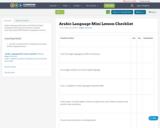
Arabic language mini lesson checklist from Qatar Foundation International's Summer Institute http://qfi.org/list/180/2/Arabic-Language-&-Culture
- Subject:
- Arts and Humanities
- Material Type:
- Assessment
- Teaching/Learning Strategy
- Date Added:
- 11/21/2013

Arabic language mini lesson checklist from Qatar Foundation International's Summer Institute http://qfi.org/list/180/2/Arabic-Language-&-Culture
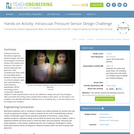
Acting as if they are biomedical engineers, students design and print 3D prototypes of pressure sensors that measure the pressure of the eyes of people diagnosed with glaucoma. After completing the tasks within the associated lesson, students conduct research on pressure gauges, apply their understanding of radio-frequency identification (RFID) technology and its components, iterate their designs to make improvements, and use 3D software to design and print 3D prototypes. After successful 3D printing, teams present their models to their peers. If a 3D printer is not available, use alternate fabrication materials such as modeling clay, or end the activity once the designs are complete.
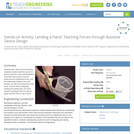
Students learn about how biomedical engineers create assistive devices for persons with fine motor skill disabilities. They learn about types of forces, balanced and unbalanced forces, and the relationship between form and function, as well as the structure of the hand. They do this by designing, building and testing their own hand "gripper" prototypes that are able to grasp and lift a 200 ml cup of sand.

An example of performance-based assessment about on family mealtime etiquette and table setting with a set criteria.
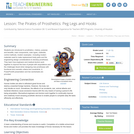
Students are introduced to prosthetics history, purpose and benefits, main components, main types, materials, control methods, modern examples including modern materials used to make replacement body parts and the engineering design considerations to develop prostheses. They learn how engineers and medical doctors work together to improve the lives of people with amputations and the challenges faced when designing new prostheses with functional and cosmetic criteria and constraints. A PowerPoint(TM) presentation and two worksheets are provided.

A portfolio assessment is a tool for testing a number of skills that aren't often testable in a single setting for traditional settings. Here is an example of portfolio assessment.
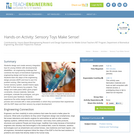
Students design and create sensory integration toys for young children with developmental disabilities an engineering challenge that combines the topics of biomedical engineering, engineering design and human senses. Students learn the steps of the engineering design process (EDP) and how to use it for problem solving. After learning about the human sensory system, student teams apply the EDP to their sensory toy projects. They design and make plans within given project constraints, choose materials, fabricate prototypes, evaluate the prototypes, and give and receive peer feedback. Students experience the entire design-build-test-redesign process and conclude with a class presentation in which they summarize their experiences with the EDP steps and their sensory toy project development.

As if they are engineers, students are tasked to design solar-powered model vehicles that are speedy and compact in order to make recommendations to a local car sales company. Teams familiarize themselves with the materials by building solar-panel model car prototypes, following kit instructions, which they test for speed. After making design improvements, they test again. Then they take measurements and calculate the volume of each team’s vehicle. They rank all teams’ vehicles by speed and by size. After data analyses, reflection and team discussion, students write recommendations to the car company about the vehicle they think is best for consumers. Youngsters experience key portions of the engineering design process and learn the importance of testing and collaborating in order to make better products. Pre/post-quizzes and numerous worksheets and handouts are provided.
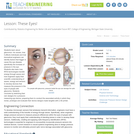
Students learn about glaucoma its causes, how it affects individuals and how biomedical engineers can identify factors that trigger or cause this eye disease, specifically the increase of pressure in the eye. Students also learn how RFID technologies transfer energy through waves and how engineers apply their scientific understanding of waves, energy and sensors to develop devices that measure the pressure in the eyes of people with glaucoma. Students conclude by sketching their own designs for a pressure-measuring eye device, preparing them to conduct the associated activity in which they revise, prototype and evaluate their device designs made tangible with a 3D printer.
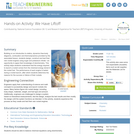
Building on an introduction to statics, dynamics free-body diagrams, combustion and thermodynamics provided by the associated lesson, students design, construct and test their own rocket engines using sugar and potassium nitrate an opportunity to apply their knowledge of stoichiometry. This activity helps students understand that the energy required to launch a rocket comes from the chemical energy stored in the rocket fuel. The performance of each engine is tested during a rocket launch, after which students determine the reasons for the success or failure of their rockets.

Students experience the engineering design process as they design and construct lower-leg prostheses in response to a hypothetical zombie apocalypse scenario. Like the well-known Apollo 13 story during which engineers were challenged to fix the crippled spacecraft with limited supplies in order to save astronauts' lives, in this activity, students act as engineers during an imaginary disaster in which a group member's leg was amputated in order to survive a zombie attack. Building on what they learned and researched in the associated lesson, they design and fabricate a replacement prosthetic limb using given specific starting material and limited additional supplies, similar to how engineers design for individuals while working within constraints. A more-advanced scenario challenges students to design a prosthesis that is able to provide a more-specific movement function.